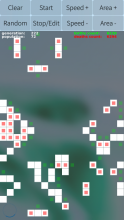Game of Life
The Game of Life, also known simply as Life, is a cellular automaton devised by the British mathematician John Horton Conway in 1970.[1]
The game is a zero-player game, meaning that its evolution is determined by its initial state, requiring no further input. One interacts with the Game of Life by creating an initial configuration and observing how it evolves, or, for advanced players, by creating patterns with particular properties.
Rules
The universe of the Game of Life is an infinite, two-dimensional orthogonal grid of square cells, each of which is in one of two possible states, alive or dead, (or populated and unpopulated, respectively). Every cell interacts with its eight neighbours, which are the cells that are horizontally, vertically, or diagonally adjacent. At each step in time, the following transitions occur:
- Any live cell with fewer than two live neighbours dies, as if by underpopulation.
- Any live cell with two or three live neighbours lives on to the next generation.
- Any live cell with more than three live neighbours dies, as if by overpopulation.
- Any dead cell with exactly three live neighbours becomes a live cell, as if by reproduction.
The initial pattern constitutes the seed of the system. The first generation is created by applying the above rules simultaneously to every cell in the seed; births and deaths occur simultaneously, and the discrete moment at which this happens is sometimes called a tick. Each generation is a pure function of the preceding one. The rules continue to be applied repeatedly to create further generations.
Sources
https://github.com/pulsar541/harbour-gameoflife
Keywords:
| Attachment | Size | Date |
|---|---|---|
| 21.92 KB | 23/03/2019 - 12:00 |



Comments
melg01
Fri, 2019/03/22 - 02:11
Permalink
Nice! Maybe you could add a counter, to keep track of the generations calculated so far.
ossi1967
Sat, 2019/03/16 - 20:07
Permalink
Thank you so much for bringing this childhood memory back to me on my Sailfish device! I loved to watch it on my 8bit computer, and I'm so happy to have it on my phone now.
nobodyinperson
Sat, 2019/03/16 - 09:34
Permalink
Nice one!
vsimonkay
Mon, 2019/03/11 - 23:53
Permalink
What's the use of this game? How can it be played? Or should one just wonder about the dfferent patterns?
Skillmon
Tue, 2019/03/12 - 20:53
Permalink
It is sometimes used as coding training. Also there are a few interesting patterns. It is just meant to be looked at, you shouldn't take its name too seriously.